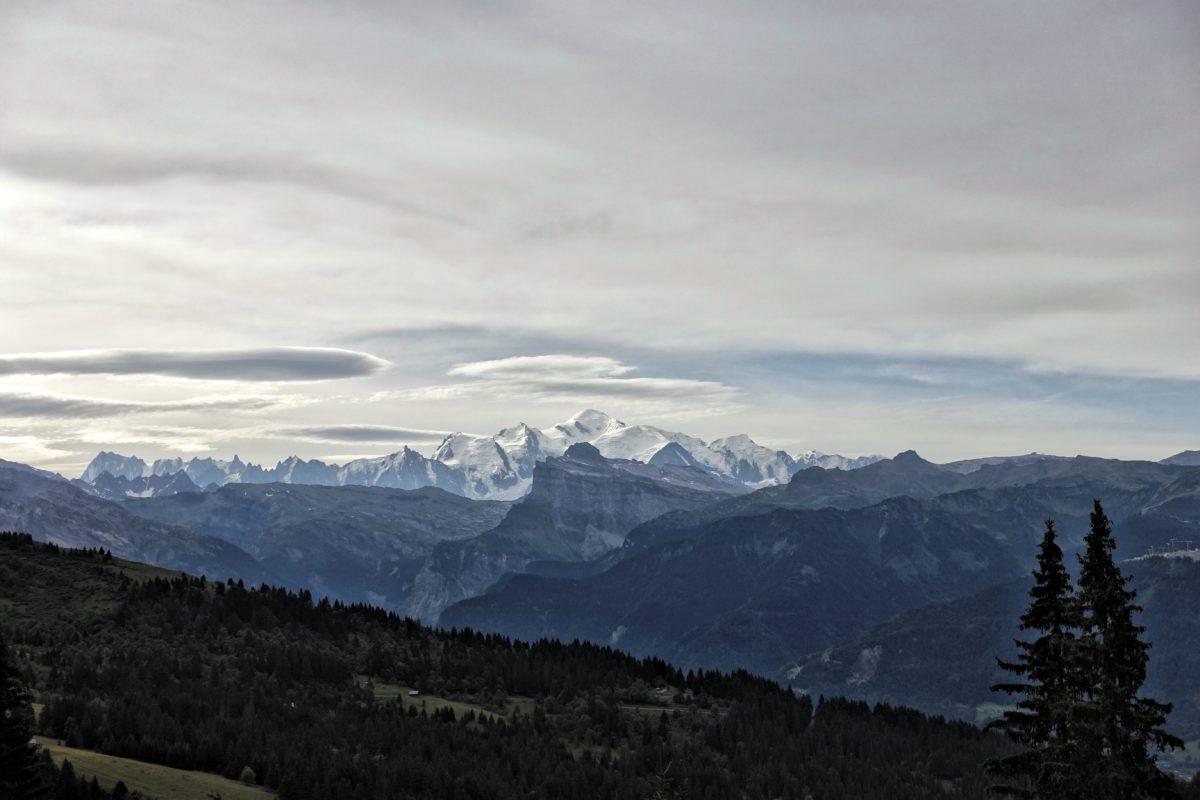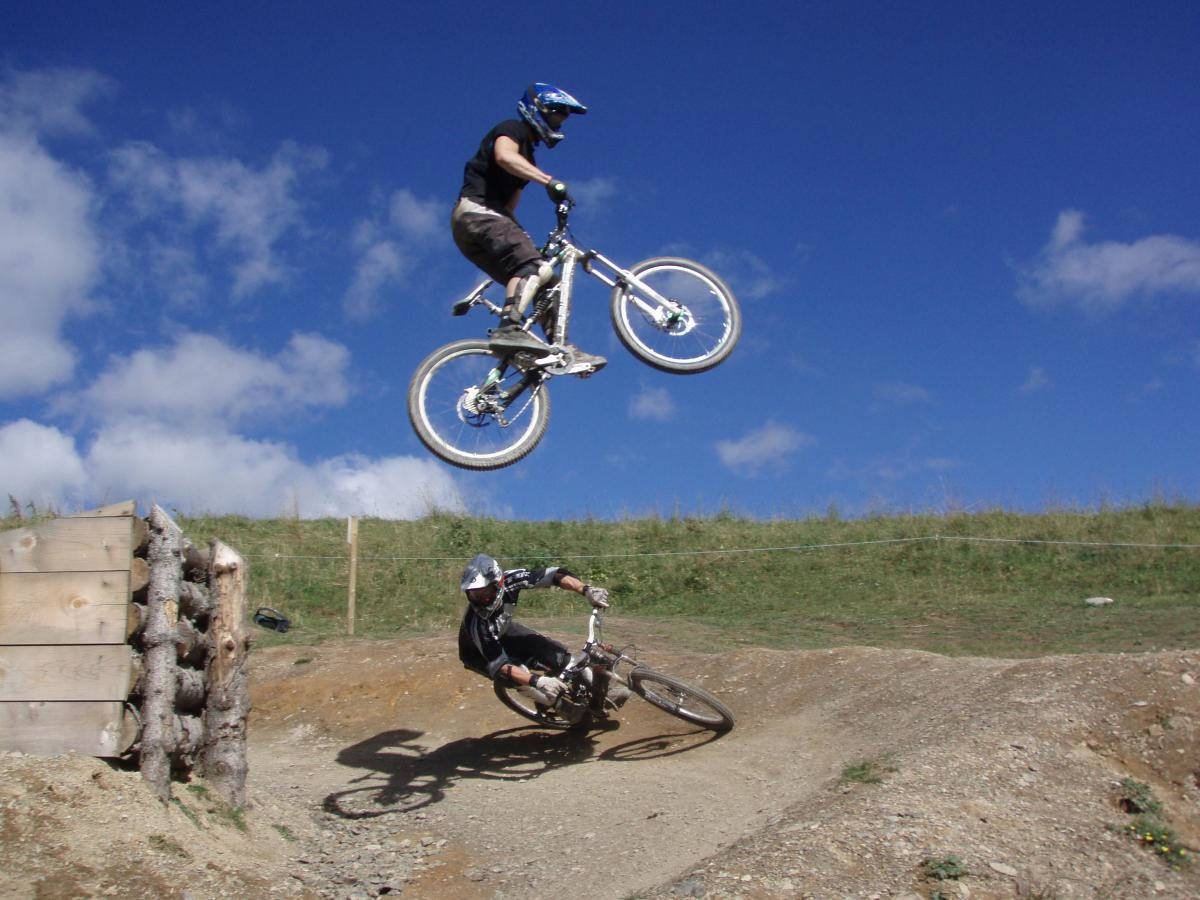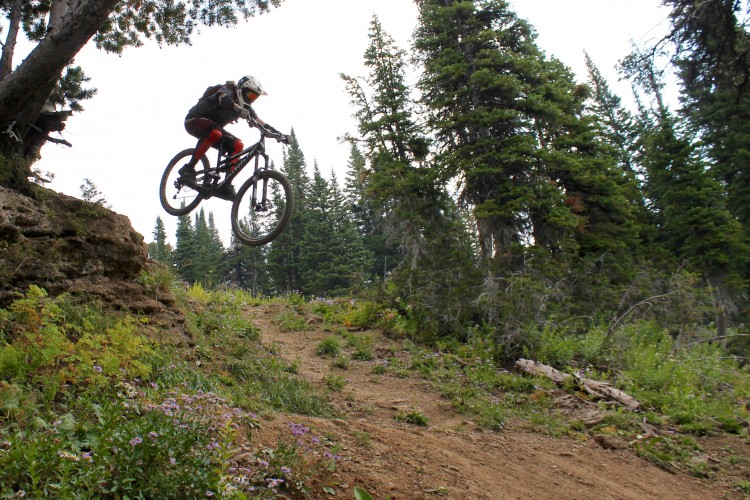
I first skied down a snowy slope at the age of 8 or 9 and from that point on, I’ve been addicted to flying down mountains at top-speed. I grew up reading all the skiing rags about the epic terrain, endless chairlifts, and deep powder found in the Alps. Ever since I was a pre-teen, one of my life goals has been to take a pilgrimage to the Alps and experience that formidable terrain for myself!
This summer saw my childhood dream finally come true! But with one notable tweak: while I originally envisioned traveling to the Alps with my skis, it was my mountain bike that finally took me there. I’m ok with that, though, as my time riding mountain bikes in the Alps was a truly incredible, once-in-a-lifetime experience!
France is a big place, and while I would have loved to explore every single resort and every single chairlift, I had to narrow my focus a bit. Specifically, I based my time in France out of the resort town of Morzine, and rode in the Portes du Soleil network of bike parks.
Portes du Soleil

Portes du Soleil is an expansive mega-resort that encompasses 12 smaller resorts. Essentially, Portes du Soleil is a partnership between this network of resorts to sell a lift ticket that provides access to all of their lifts. While many more lifts are open during the winter than during the summer, Portes du Soleil claims an interconnected network of 25 summer lifts, with the ability to connect to even more lifts over the mountains, extending into Switzerland.
Let that sink in for a second: 25 lifts. For mountain biking. On one lift ticket.
For comparison, Whistler has two chairlifts that run for mountain biking.
And the lift ticket itself isn’t even that expensive. A day ticket costs just €23 (about $25 USD), and a season pass can be purchased for about €200.
While Portes du Soleil refers to the entire area, you’re more likely to have heard about each bike park individually, such as Chatel, Champery de Crosetes, Les Gets, Morgins, Super Morzine, and of course Morzine itself. Yes, all of these bike parks, each with its own flavor and area of expertise, comprising dozens of signed downhill runs and even more unsigned trails, are all ripe for the picking with a €23 pass!
Riding the Pleney

The Pleney lift is a gondola that rises straight out of Morzine, forming the closest-to-town ski area and bike park. I met up with my guide, Jo Pauly of RideAbility, at the bottom of the lift, and I began to get the entire run down on the area.
The trails under the Pleney lift are famous for being some of the original downhill tracks in the region, with the main trail known as the “Main Line.” Morzine, along with nearby Les Gets, has hosted many downhill races over the years, from World Cups to World Champs. Consequently, the Main Line is a true-blood downhill race track, complete with brutal rock gardens, jumps, drops, endless braking bumps, and a general sense of gnar that can and will destroy you. We eventually rode just one portion of the main line, and on my puny Santa Cruz Bronson trail bike, it was plenty!
But for our first run of the day, we dropped into the main intermediate trail, which runs top to bottom. Receiving a blue rating on the trail map, this intermediate trail, Jo informed me, was the easiest trail on the mountain.
After ripping through high-speed berms, manualling through a few mud holes, skimming over webs of roots, and generally hanging on for dear life, I had a hootin’, hollerin’ good time! But as we reached the bottom of the mountain, I thought back on the run: “that’s seriously the easiest trail out here?! I’m glad I didn’t bring a beginner friend along for the ride.”
While Jo does some guiding, his main gig during the summer is mountain bike skills training, as his company’s name would indicate. While he doesn’t force skills training on anyone who doesn’t want it, there’s been more than one occasion where a guiding gig turned into a coaching gig because the client simply didn’t have the skills necessary to ride these trails.
After another run or two to warm up, we grabbed a trail across the mountain, over to Les Gets. Click below to read more…
Les Gets Bikepark

While Morzine and the Pleney have a long history, nearby Les Gets is, if anything, more cemented in the collective mountain bike consciousness thanks to recently playing host to a 2016 Crankworx Tour stop.
Many of the Crankworx stunts–like the famous slopestyle course–are much too intense for the average, everyday rider, and are decommissioned every year. The cross planks for the elevated bridges are pulled off, and some of the biggest hits are roped off and inaccessible from the standard trails. However, some of the milder features, such as the speed and style course, have been integrated into the daily downhill trails. Even that course has been tamed, with some of the jumps being cut down, but what remains is still an impressive course with absolutely giant berms and massive jumps.
Everyone knows the jumps and berms never look as big in the videos as they do in real life, but when you actually travel to a place like Les Gets that you’ve seen in endless videos and actually ride those berms for yourself, it’s a whole different story!
I was on a Santa Cruz Bronson trail bike and I’m not that adept at jumping to begin with, but just hanging on and pinning it around those berms was hard enough on its own! These berms were easily the largest I’ve ever ridden in my entire life–some of them had to measure at least 15 feet tall!
Railing the berms and attempting to get a tiny bit of air put the entire speed and style competition into perspective for me. While perhaps speed and style doesn’t get nearly the acclaim that the slopestyle competition and the stunts looming high above us receive, it’s apparent that everything that the pros do is mad difficult!

Les Gets’s bike park is much more developed and spread out than the trail network below the Pleney lift, with two different chairlifts serving two distinct portions of the park. The first chair down to the base area is home to the Crankworx courses and the legit DH trails, and the second chair, further over to the skier’s left, is home to a collection of much more intermediate-friendly trails–at least, overall.

While I rode a few of these with Jo, I explored the majority of them on my own toward the end of day two. While there is at least one crazy-technical black trail with massive gaps and big hits (see photo above), most of the trails in this zone are intermediate and advanced, and more than rippable on a trail bike.

In fact, I found many of these intermediate flow-style trails to feel basically the same. As you can see from the photo above, which doesn’t even show the entire mess of trail, Les Gets has packed as many bermy flow lines as possible into this zone, in an effort to spread riders out. While I got bored of riding flow trails after a dozen or so runs in one afternoon, these trails are extremely popular, and many riders are content to just session lap after lap after lap.
This hard riding and constant traffic was very evident in the trail tread itself. Referring to this entire bike park as “blown out” would be an understatement. Braking bumps is the name of the game, with braking bumps into turns, into jumps, through turns, blown out berms, dished out straightaways, mowed-down lips–these trails have been absolutely brutalized by the near-constant traffic.

When Jo was explaining the area bike parks to me, he noted how expansive the area was, but did slip in the caveat that many of his customers claim that bike parks such as Whistler are much better maintained than the bike park trails around Morzine.
It seems to me that it would be hard to have bike park trails that are in worse condition than the ones I saw at Les Gets. I mean, maybe it’s possible–but the abuse these trails have seen can literally be observed from the lift.
While I had a great afternoon pulverizing the Bronson through braking bumps, my personal singletrack affinity lies outside of the bike park–way, way outside of the bike park–on remote, technical, narrow singletrack trails. And the rest of the trip would feed my hunger for backcountry riding admirably!
Pro Racer Practice Zone

While the majority of the signed bike park trails around Les Gets are rideable on a trail bike, the signed trails are only half the story. This entire region is filled with illicit “hardcore freeride trails,” as Jo calls them. The building of such trails, as you might imagine, isn’t legal. But the law of the land states that unless a “no bikes allowed” sign is posted on a trail, then by default it’s legal to ride on your mountain bike. So while you aren’t legally allowed go out and build one of these trails, you can legally ride them. It’s a bit of a political gray area, but one that is exploited by the lift companies and their thousands of riders, including some of the best downhillers in the world.
Europe is home to the majority of the stops on the UCI World Cup Downhill tour, claiming six of the eight races on the 2016 schedule. With many of the races just weeks apart, for cash-strapped pros traveling from around the world to race in Europe, it doesn’t make sense to fly home only to turn around and fly back around the world in a week’s time. So, many of the pros just hang out in Europe, practicing and training between events.
Morzine/Les Gets is one of the primary locales where the pros gather.
In order to train for the insane downhill and freeride tracks they compete on, many racers have taken to building practice tracks in the deep pine forests surrounding Morzine and Les Gets. Generally the trail will stay secret for a few years, making it the perfect training ground. But then eventually word gets out, and the masses of tourists start pummeling these super steep fall line trails that were never intended for massive traffic, eventually turning them into a gnarled gully of a trail. And then the builders move on and build another track, train there until it gets blown out… and the process repeats itself.
As a result of the many years of illegal building, the trail network in this area is vast–much more expansive than any map will ever show.
To get a taste of the absolute insanity found on these trails, check out this video that Brendan Fairclough posted to his Facebook page the week before I traveled to Morzine:
Towards the end of our first day Jo turned to me and asked, “so, do you want to try out one of the hardcore freeride trails?”
“Heck yeah!” I responded. While I wasn’t certain that I could even ride it, I’m never afraid to walk my bike, and I couldn’t wait to get a taste of what these unmarked ribbons of dirt were like.
While I did stop a few times to scope the lines before I dropped in, I was able to ride everything with only a moderate amount of fearing for my life–it was one of the steepest trails I’ve ever put two tires to!

At the bottom I turned to Jo and said, “that was one of the easiest ‘hardcore freeride’ trails, wasn’t it?”
“Yes, yes it was,” he responded with a knowing smile.
End of the Season
It turned out that the only weekend that I could squeeze Morzine into my packed 3-week European excursion was actually the final weekend that these three lifts would be open. In fact, some of the other lifts had already closed the weekend before, on the final weekend in August. Unfortunately, one of the primary conduits from the Morzine/Les Gets area to the rest of Portes du Soleil was one of the lifts that had closed the weekend prior, limiting us to just these three lifts. But saying that we could just ride three lifts and dozens of trails in a short two days of riding in Morzine is like saying that we were just mountain biking in the Alps.
Consequently, I highly recommend booking your riding trip to Morzine before the end of August, and if you truly want to explore the full extent of Portes du Soleil, you better plan to dedicate a solid week to that endeavor!
Base Camp: Reach4thealps in Morzine

The town of Morzine is renowned as a resort town in the Alps, both for summer and winter tourism. Located in central France, in the northwestern reaches of the Alps, it is extremely popular with the British, as it is one of the most easily-accessible big mountain destinations to the UK. While you can fly into Geneva and take a shuttle to Morzine like we did, Many Brits opt to simply drive the 11+ hours from London to Morzine.

Thanks to the familiarity it has garnered as a tourist destination, Morzine is full of British expats trying to escape the rat race of London by starting a new life in the mountains. According to Jo, the stereotype here is the overworked Londoner who quits his job, moves to Morzine, and starts a chalet company—subsequently going out of business in 2-3 years when they realize that despite living in the mountains, owning and running one’s own business in a mountain town is, if anything, even more challenging than working a 9-5 in the city.
Gina and Marcus Ewart, however, have successfully bucked the stereotype. While they are indeed British expats who started a chalet company, named Reach4thealps, they’ve managed to resist burning out and going out of business. Instead, they’ve built one of the longest-running and most-successful chalet businesses in the Morzine/Les Gets region, first opening their doors over 14 years ago in 2002, and continuing to expand their reach even today.


While everyone in Morzine seemed to know what a “chalet company” was and take it for granted, putting those two words together in American English doesn’t directly translate, and it took me a while to piece together exactly what it is that Reach4thealps does.
“Chalet” literally means “a wooden house or cottage with overhanging eaves, typically found in the Swiss Alps,” according to Google. However, the term “chalet company” has its own unique meaning. In the States, the closest equivalent would be a company that manages vacation rentals… but even then, that comparison falls flat.
Instead, in American terms, I would call what Reach4thealps does as a cross between a vacation rental management company, a catering company, and a bed-and-breakfast.

During the winter, if you book a property with Reach4thealps, you’ll likely be booking a catered property, which means that a pair of cooks live on-site and will cook top-notch, chef-quality cuisine for the duration of your trip.
Obviously for the overhead cost to make sense, it would be best to get a bunch of your friends together to go in on the chalet as a group, and Reach4thealps offers properties that can handle up to almost 20 people, or as little as two.
While catering is a big thing for Reach4thealps during the winter, they’ve found that during the summer, mountain bikers aren’t as keen on the catering aspect. Instead, most groups of mountain bikers prefer to bring their own food, cook it on the grill, and save some cash. As a result, out of Reach4thealps’s 14 properties, only one is catered all summer long: their main Brown Bear Lodge. However, any of their properties can be booked as a catered property, if the party so desires. Just get in touch with Reach4thealps to work things out.

Since Reach4thealps is such a big operation, it’s difficult to summarize all of the options that they offer, but basically, you can book as large or as small of a property as you’d like, with a plethora of locations available. For instance, my wife and I stayed in a small two-bedroom basement apartment-style rental just three blocks from the Pleney lift. But again, you can book an entire chalet that will fit well over a dozen people.
While we thoroughly enjoyed our self-catered experience and found it to be supremely relaxing, we also got a taste–literally–of the Brown Bear catered experience, joining the folks at the lodge for an exceptional meal! A group of athletes from all over Europe had gathered in Morzine for a Reach4thealps triathlon training camp, and we got to crash their meal. From hot drinks before the meal to the exquisitely prepared courses, the evening at Brown Bear now seems to be a dream. The quality of the delicious food and the presentation were on par with fine dining you’d expect from the nicest restaurants in town, with the setting to accompany it.

However you want to experience Morzine–whether fending for yourself, or having a qualified chef prepare all of your meals–you can book that experience yourself. Just check out the options on Reach4thealps’s website, or drop them a line if you have specific questions, and they’ll be sure to set you up! While the mountain bike season is currently over in Morzine, it’s never too early to start planning for next year, as the popular weekends can get booked up quickly.
Tune in tomorrow for an overview of the more primitive side to Morzine’s singletrack!
Thanks to Reach4thealps and RideAbility for making this trip possible!



















